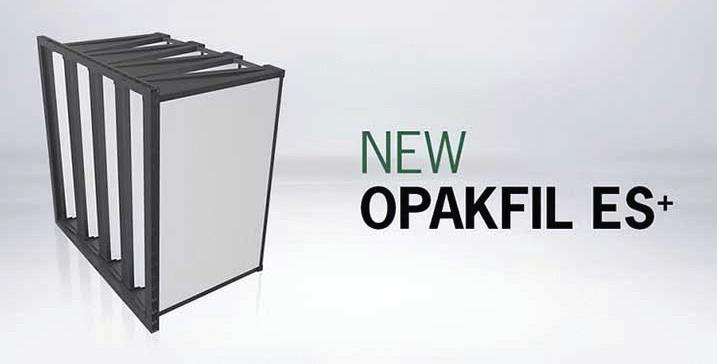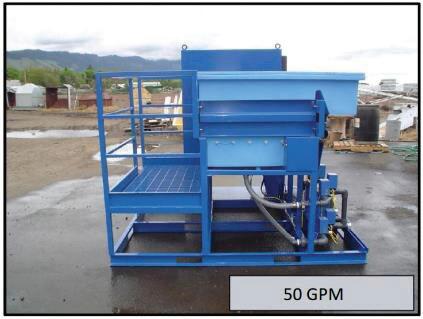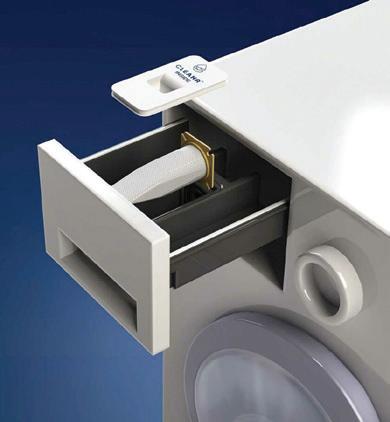
3 minute read
Camfil Unveils Opakfil ES+: Enhanced Design, Enhanced Performance
Camfil, a global leader in clean air solutions, announced the launch of the Opakfil ES+, the latest innovation in compact V-Bank air filters. Designed to meet the growing demand for energy-efficient and sustainable HVAC solutions, the Opakfil ES+ offers superior performance, extended operational life, and significant environmental benefits.
Building upon the success of the original Opakfil ES, the Opakfil ES+ features an increased filter depth, resulting in a larger amount of filtration media. This enhancement leads to a higher dust holding capacity, allowing the filter to last up to 50% longer in HVAC systems. The extended lifespan not only reduces maintenance frequency but also minimizes waste and labor costs, contributing to a lower total cost of ownership.
Energy efficiency is at the core of the Opakfil ES+ design. The filter achieves a 62% reduction in energy consumption compared to the industry average and a 24% reduction compared to other A/A+ rated compact filters. This remarkable performance is attributed to its low pressure drop and aerodynamic radial design, which optimize airflow and reduce energy usage.
The Opakfil ES+ is available in ePM1 and ePM2.5 efficiencies, in accordance with ISO 16890 standards, ensuring high indoor air quality across various applications. Its molded frame, constructed from recycled plastic, underscores Camfil’s commitment to sustainable manufacturing practices. www.camfil.com
Great Lakes Filters Offering Electrocoagulation (EC) Technology to Destroy PFAS
Great Lakes Filters, a leader in industrial filtration solutions, announced the offering of patented Electrocoagulation (EC) technology that destroys PFAS “forever chemicals” in industrial wastewater and landfill leachate streams immediately and on-site. This groundbreaking technology is the most cost-effective solution to meet strict U.S. EPA and Michigan EGLE discharge limits.

PFAS compounds, notorious for their resistance to degradation, pose a significant environmental and health risk due to their stability and bioaccumulative properties. Michigan currently enforces a 12ppt limit. Compliance with these stringent regulations has previously required expensive and complex treatment methods, including pre-filtration and off-site disposal. Great Lakes Filters’ new EC technology destroys PFAS compounds at their molecular level, eliminating the need for secondary processing and reducing liability by preventing the transportation and disposal of hazardous materials.
Unlike existing PFAS capture technologies such as dissolved air flotation, ion exchange resin (IXR), granular activated carbon (GAC), nanofiltration (NF), and reverse osmosis (RO), which only separate or adsorb PFAS without fully eliminating them, EC technology breaks the fluorine-carbon bond within the PFAS structure, rendering the chemicals harmless. This process also removes both dissolved and suspended solids, kills pathogens and viruses, and consistently meets water standards, all while significantly lowering operational and capital expenses. www.acmemills.com/greatlakesfilters p Separation membrane module structure.
High-Efficiency Membrane Doubling Filtration Performance
Toray Industries, Inc., announced that it has developed a high-efficiency separation membrane module for biopharmaceutical manufacturing processes. This module delivers more than double the filtration performance of conventional counterparts by reducing clogging. It should also lift biopharmaceutical yields to more than 90% and enhance purification. The company will initially supply prototypes to diverse customers to evaluate in purification processes for producing gene therapy drugs with a view to swift commercialization.
Recent years have seen the pharmaceutical market shift from conventional small-molecule drugs to biopharmaceuticals. Gene therapies and other treatment modalities are also coming to market in what seems to be an ongoing trend. A prime downside is the high manufacturing costs for these biopharmaceuticals, which are driving up medical expenses.
Gene therapy drugs are made with cultured cells. Purification entails using a depth filter to remove cell fragments from the culture medium, after which an ultrafiltration membrane removes impurities like proteins. Depth filter clogging or gene therapy drug adhesion to the ultrafiltration membrane can cause active ingredient losses, leading to higher costs.
The module comprises a depth filter incorporating multiple types of non-woven fabric and a hollow fiber ultrafiltration membrane. www.toray.com
The Shaw Institute Validates CLEANR for Washing Machines Is Over 90% Efficient
The Shaw Institute, a nonprofit science research organization, has tested CLEANR’s external microplastic filter for washing machines and certified it to be over 90% efficient at capturing microplastics as small as 50-microns. CLEANR for Washing Machines will be available for purchase in the U.S. later this year.

CLEANR’s technology, VORTX, is unique among microplastic filtering solutions for washing machines. CLEANR’s design was inspired by manta rays and basking sharks whose unique gill structures allow them to glide through the water and feed passively without clogging their gills. Instead of forcing particles against a filtering surface like conventional filters, VORTX creates vortices which suspend and isolate microplastic particles from washing machine wastewater and channel them into the CLEANR Pod, a microplastic capture unit, which ensures proper disposal of the microplastics.
The Shaw Institute tested the effectiveness of CLEANR for Washing Machines by running a mix of tap water and plastic flock fibers (10 microns in diameter and 300 microns in length) through the filter at various concentration levels to simulate real world laundry conditions. The test was repeated three times in January and February and resulted in 90%, 97%, and 98% microplastic fiber removal rates. www.shawinstitute.org










